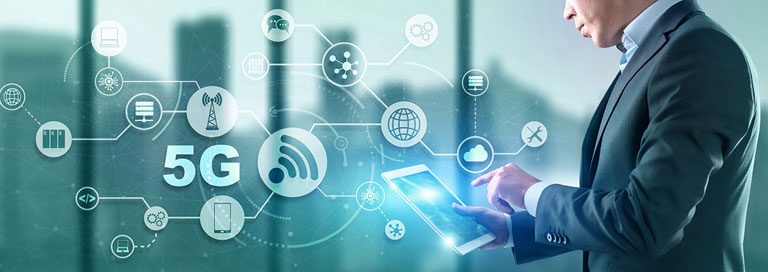New generation of cellular networks offers immediate business benefits as well as countless potential possibilities.
Cellular networks have transformed the way we live and work, but the most profound changes may be yet to come. Analysts predict fifth-generation (5G) broadband cellular networks will generate trillions of dollars in economic value over the next few years by resolving a host of business and societal challenges while establishing a framework for experimentation and innovation.
With data transmission rates of up 10 gigabits per second, 5G can deliver mobile browsing and download speeds up to 20 times faster than 4G networks — some say it will actually be closer to 100 times faster as networks expand and mature. ABI Research predicts the technology will generate $7 trillion in economic value by 2030 as businesses leverage the increased speed and capacity with new use cases and applications.
“5G is now giving us a glimpse of what will be possible in the future and setting the foundation for the next generation of networks,” said Dimitris Mavrakis, senior research director at ABI Research. “The high capacity, high reliability and low latency capabilities of 5G are now starting to create the next wave of consumer and enterprise applications, in the very same way 4G seeded the creation of social networks, the collaborative economy and rich content.”
A History of Innovation
It's worth remembering how successive generations of cellular networks have influenced communications and computing since the 1980s. First-generation networks based on analog technology made mobile telephony ubiquitous before digital 2G enabled text messaging and mobile email access. In 2000, higher-capacity 3G networks enabled mobile Internet access before 4G ushered in the era of smartphones with as much computing power as a PC.
Introduced in 2019, 5G is moving toward mainstream acceptance, according to a recent report from the Ericsson Consumer Lab. The report forecasts that at least 30 percent of smartphone users intend to upgrade to 5G within the next year.
By combining fiber-like performance with the versatility of a wireless connection, 5G-enabled devices will provide the real-time data delivery necessary to ultimately bring technologies such as smart cities, autonomous vehicles, augmented reality and virtual reality into mainstream usage. In the meantime, 5G will support a number of more immediate use cases.
Remote Work
The most immediate benefit for most organizations will be improved service for branch offices and remote workers. Greater speed and capacity will dramatically improve wireless connectivity for those folks, providing faster and more reliable access to network and cloud resources. Online file-sharing and collaboration will also become faster and more efficient. Perhaps most important, 5G enables vastly improved security for those outside the network perimeter through built-in features such as end-to-end encryption, mutual authentication, deep packet inspection and anti-spoofing filters.
Internet of Things
IoT devices require a connectivity solution to move data from collection points, across private networks or the public Internet, and finally to cloud-based analytics engines. Wired LAN connectivity is an option, but it is limited to locations that can be reached by cabling. Wi-Fi is usually the preferred choice, but distance, capacity and scalability are all challenges. 5G enables extremely fast and reliable connections that leverage existing cellular infrastructure — IoT devices only require standard SIM cards to connect. In addition, 5G will support “smart” devices that can connect with each other and conduct onboard data processing, providing better data insights, improved device monitoring and enhanced device diagnostics.
Network Slicing
With 5G, organizations can “slice” a single physical network into multiple virtual networks that can be tailored for different services or customer segments. Each slice can have unique bandwidth, throughput and capacity characteristics, which will allow organizations to control network resources and adjust traffic patterns on an extremely granular level. The technique also offers some security benefits. In the event of an infection, it can limit malware’s ability to propagate throughout the network.
Customer Service
5G enhances an organization’s ability to collect, move and process large data volumes in order to deliver personalized customer experiences in near real time. Everything from customer support, credit applications, order processing, mobile transactions and billing inquiries will become faster and more convenient. 5G is also accelerating the development of chatbots, virtual assistants and enhanced videoconferencing to streamline the customer experience. Retail businesses, in particular, are eager to use 5G-driven augmented reality and virtual reality solutions to create fully immersive experiences.
Business Continuity
The ability to seamlessly failover to a backup Internet connection if the primary connection fails is a key element of business continuity plans. Although U.S. businesses experience more than 500 hours of Internet downtime each year on average, more than half have no failover plan in place. With a 5G failover solution, a cellular gateway automatically redirects traffic to the high-speed cellular network without the need for any manual intervention.
Temporary Operations
First responders, utility companies and construction crews are among the many groups that often need to establish temporary locations with secure and reliable access to data, applications and network resources. However, it can take months to establish WAN connectivity. With 5G, cellular network connections can be established quickly with minimal involvement of IT with plug-and-play edge routers.
Last-Mile Connectivity
Approximately 42 million Americans still lack reliable broadband connectivity, according to a recent Broadband Now report. That’s largely because laying last-mile fiber networks in sparsely populated areas is exorbitantly expensive. 5G makes such areas reachable with low-power, short-range cellular antennas that can be installed on street lights, utility poles and other city infrastructure to increase increased cell density. Short transmission hops between cells improve throughput, and the increased cell density allows more simultaneous connections.
“The progress of 5G continues throughout the Americas with more spectrum, coverage and usage,” said Chris Pearson, president of the 5G Americas trade association. “We are entering an era of innovation with an expanding 5G ecosystem that is learning how to take advantage of the technical capabilities of this great technology.”




